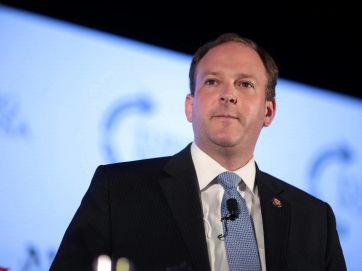“Forward.” is President Obama’s campaign slogan. He explains: “The question in this election is which way do we go? Do we go forward to a new vision of an America in which prosperity is shared, or do we go backward to the same policies that got us into this mess in the first place?” (The White House, Remarks by the President at a Campaign Event, Bridgeport Arts Center, Chicago, Illinois, August 12, 2012)
But, ironically, President Obama proposes not to take us forward, but way back— before the policies of “the last thirty years,” before Ronald Reagan became president in 1981.
In the decades after World War II, there was a general consensus that the market couldn’t solve all of our problems on its own; that we needed certain investments to give hardworking Americans the skills they needed to get a good job, and entrepreneurs the platforms they needed to create good jobs….In the last century, this consensus—this shared vision—led to the strongest economic growth and the largest middle class the world has ever known. It led to a shared prosperity. It is this vision that has guided my economic policies….
(The White House, Remarks by the President on the Economy at Cuyahoga Community College, Cleveland, Ohio, June 14, 2012)
President Obama “seems to suggest, let’s just dial up the economic Way Back Machine,” observes James Pethokoukis, “and we can go back to the future.” (“Looking backward: The nostalgia economics of Barack Obama,” American Enterprise Institute, June 15, 2012)
But there’s no going back Mr. President. The post-World War II decades were affected by a host of unique factors, not the least of which was that they came right after a devastating global war that left America’s competitors in ruins. A National Bureau of Economic Research study described the situation this way: “At the end of World War II, the United States was the dominant industrial producer in the world…This was obviously a transitory situation.”
Demographics, technology and globalization—has Obama noticed how any of these have changed over the past half century?…The president seems to be doubling down on an obsolete economic model where growth is driven by expanding public sector union employment and a clean-energy version of industrial policy. Looking backward—and drawing the wrong conclusions—is no way to move forward.
Moreover, Pethokoukis reports in “Obama’s Big Experiment” (Commentary, September 2012, requires subscription) that the president is “under the sway of a new post-Keynesian economic theory.” Peter Diamond and Emmanuel Saez argue that “higher top tax rates” (which prevailed in the post-war decades) “tend to go with higher economic growth.” (“Diamond and Saez: High Tax Rates Won’t Slow Growth,” The Wall Street Journal, April 23, 2012)
In Productivity, Finance, and Growth, I explained how, starting under President Kennedy in 1961, amplified by the Great Society programs of 1964-1965, and continuing with the support of all the following administrations until 1981, the flawed ideas of academic social science led to what economics columnist Robert J. Samuelson calls “the great inflation.” Academic economists argued that the economy could be kept perpetually near “full employment” by stimulative government spending, “without the need to rely on the ‘animal spirits’ of businessmen.” The result, as the above articles substantiate, was economic stagnation and double-digit inflation: stagflation
Referring to that period, Samuelson recently asked (“Why U. S. Economic Policy is Paralyzed,” The Washington Post, July 8, 2012):
Wondering why government can’t restart the sluggish economy? Well, one reason is that we are still paying the price for the greatest blunder in domestic policy since World War II. It destroyed the intellectual and moral props for balanced budgets. Norms changed….Politicians could spend more and tax less. This appealed to both parties and the public. Since 1961, the federal government has balanced its budget only five times. Arguably, only one of these (1969) resulted from policy…We are now facing the consequences of all these permissive deficits….
Economic policy is trapped between weak demand and too much debt.
In Cleveland, President Obama also said that
this election presents a choice between two fundamentally different visions of how to create strong, sustained growth….I believe you can’t have a strong and growing economy without a strong and growing middle class. This has to be our North Star—an economy that’s built not from the top down, but from a growing middle class.
Columnist Daniel Henninger comments in The Wall Street Journal (“It’s a Single-Issue Election,” June 20, 2012) regarding what he calls the “Obama counter-theory” of economic growth—“our North Star.”
There is no theory anywhere in non-Marxist economics that says growth’s primary engine is a social class. A middle class is the result of growth, not its cause. Barack Obama not only believes in class-based growth but has built his whole growth strategy around it.
What is the basis for President Obama’s assertion that the middle class causes economic growth? David Madland presents an explanation in a paper for the Center for American Progress (“The Middle Class Grows the Economy, Not the Rich,” December 7, 2011) and an article (“Growth and the Middle Class,” Democracy: A Journal of Ideas, Spring 2011). Referring to another presidential speech (The White House, Remarks by the President on the Economy in Osawatomie, Kansas, December 6, 2011), Madland writes:
The speech President Obama delivered yesterday on the state of the middle class was a forceful refutation of the failures of supply-side economics. Most promisingly, it reached for an alternative theory of economic growth based on the role of the middle class….Aspects of the president’s speech closely paralleled an article I wrote on the topic a year ago…
Consider that from 1947 to 1979, when the middle class received 54 percent of the nation’s total income on average, the economy grew at a steady clip of 3.7 percent per year. That was 1 percentage point higher than the 2.7 percent rate it grew at from 1980 to 2010, when the middle class was weakening to its current share of only 46 percent.
Such an anecdote does not establish cause. Madland also makes a Keynesian argument: Middle class consumption and demand, not entrepreneurs and innovation, drive investment and growth. Government needs to spend more to stimulate demand.
To the contrary, Arthur Herman shows in another article in Commentary (“How America Got Rich,” September 2012, requires subscription), fast post-war economic growth was not due to stimulus of demand,
but instead, a threefold combination of renewing economic productivity, imposing tax cuts, and encouraging business savings capitalized as investment—together with the bias toward entrepreneurship and innovation that has always characterized the American economy.
Independent commissions (Simpson-Bowles, Domenici-Rivlin) as well as the Business Roundtable have identified tax reform as key to faster economic growth—reducing tax exclusions and loopholes in concert with lowering individual and corporate marginal tax rates, which I discussed in Taxation.
I elucidated in Growth that if our economy continues to grow at an average annual rate of only 2 percent between now and 2050, as it has since 2000, federal revenues will fall short by as much as $50 trillion, roughly the projected cost of unfunded liabilities for Social Security, Medicare, and Medicaid. The editors of The Wall Street Journal (Review & Outlook, August 28, 2012) put it more starkly:
Without a sustained recovery in national output to 3 percent growth or more…there is no politically feasible spending reduction or tax increase that could balance the budget even if Ron Paul ran Congress. ...The growth deficit, not the budget deficit, is the great issue of our time.
What has higher education contributed to understanding and resolving this national issue? As NAS has long argued and I explicated in Exchange and Schumpeter, our college-educated elites have been taught Marxist theory’s hostility to capitalism—not basic economics. And in Postmodern Philodoxers I illustrated why such elites might think they can simply decide that backward is forward and effect is cause, the subject of next week’s article.
______________________________________________________________________________
This is one of a series of occasional articles applying the lessons of Western civilization to contemporary issues relevant to the academy.
The Honorable William H. Young was appointed by President George H. W. Bush to be Assistant Secretary for Nuclear Energy and served in that position from November 1989 to January 1993. He is the author of Ordering America: Fulfilling the Ideals of Western Civilization (2010) and Centering America: Resurrecting the Local Progressive Ideal (2002).













